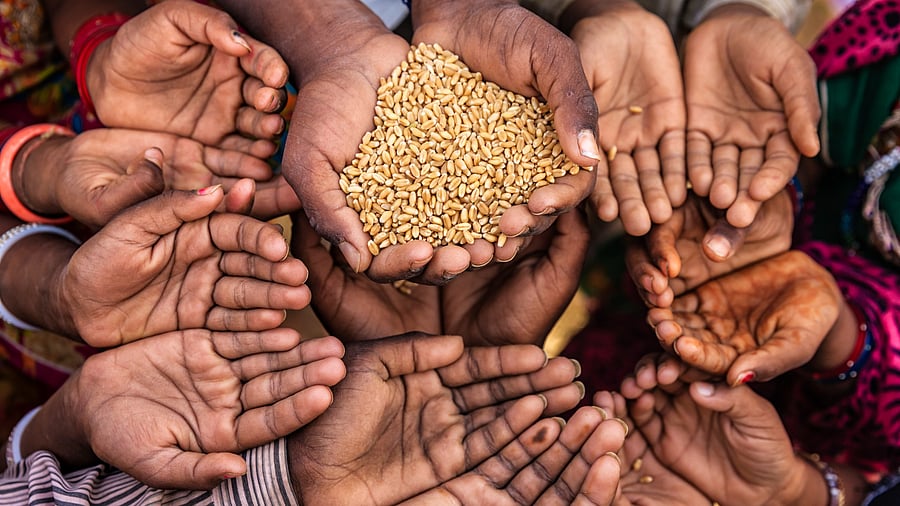
Representative image of people asking for food.
Credit: iStock Photo
India has always been known for its binaries. We have witnessed the rise of mighty empires and the onslaught of formidable invaders. Our land is rich with ancient wisdom, but we were also known as a ‘country of snake charmers and beggars’ and now the divide between India and Bharat. After independence in 1947, subsequent efforts tried to bridge these divides, but the most sordid one still gapes at us.
In the 20th century, we weathered three severe droughts, but the last five years witnessed consecutive record-breaking harvests. The green and white revolutions in the last century propelled us from being a net importer to a significant exporter.
With the record production of 1,308.3 million metric tonnes (MMT) of rice and 1,121.9 MMT of wheat in 2023, we are counted among the foremost cultivators. Besides this, we grew 205 MMT of vegetables and 107 MMT of fruits. Their exports have contributed an income of Rs 20,000 crore. Moreover, With 221 million tons of milk and 130 billion eggs, we have cemented ourselves as a self-sufficient and self-efficient nation. Remarkably, despite rapid industrialization and urbanisation, India is still an agro-economy, and agriculture still contributes 19% of our Gross Domestic Product.
In terms of storage capacities for this massive production, our storage infrastructure falls short, accommodating 1,450 MMT, leaving a deficit of 1,660 MMT against our gross produce of 3110 MMT. Shockingly, the latest data reveals that we lose 1,500 metric tonnes of grains to rats and rain because of the inadequate storage system. This is almost equal to the total production of grains by a few countries. Another report (the UNEP Food Waste Index Report) informs us that every Indian wastes about 50 kg of food and edibles annually and a staggering 69 million tonnes nationally. This wastage amounts to a whopping 92,000 crores being squandered every year, while paradoxically, we take pride in leaving leftovers on our plates.
This wastefulness impacts not only the hungry but also has consequences for the climate. The resources we expend to cultivate every gram of grain include water, land, energy, and labour, not to mention their contribution to carbon emissions. It is heartbreaking that it takes around 28% of the world’s cultivated area and about 10% of greenhouse gas emissions annually to produce the food that ends up either rotting in landfills or being discarded on roadsides, while a third of the produce doesn’t even reach the dining tables. Despite producing an ample surplus—more than enough food for the globe—we fiddle with malnutrition and hunger data.
The above data must be read along with certain other data. The recently released Global Hunger Index Report (GHI) places India in a dismal 107th position among 121 countries. Surprisingly, smaller countries (geographically and economically) like Nepal, Bangladesh, and Pakistan have fared better than us.
The GHI evaluates four key factors: undernourishment, child malnourishment, child undernourishment, and child mortality rate. According to this report, 3% of our children suffer from ‘wasting,’ denoting skewed height-weight proportions, and a staggering 35% of Indian children suffer from ‘stunting,’ indicating a lower age-height ratio. Even after almost 30 years since the launch of the mid-day meal scheme, according to the available data, we significantly lag behind our goals; discrimination and corruption entrenched at the grassroots level worsen the situation. Reports of salt and roti being served as mid-day meals instead of the recommended nutritional standards, as per the PM Poshan scheme, of 450 Calories and 40 grams of protein for primary and 700 Calories and 20 grams of protein for upper primary classes, have resulted in a reporter being incarcerated for over a year.
This GHI report marks India with a score of 29 out of 100, which is in the ‘severe hunger’ category. In India, we have a 22.5 crore malnourished population, which is about one-fourth of the world’s total number of malnourished people, which is 89 crore. If we could plug these gaps and strengthen the public distribution system, we may be able to pull this population out of chronic hunger and starvation.
The support for agriculture through MSPs and subsidies is another area of concern. Every agriculture commission since Independence has asked us to take measures to double farm income. The government’s support for agriculture has been going south for the last decade. Last year, the Government of India invested 4.3% of GDP in agriculture, which is 0.9 less than in 2013, when we invested 5.4% in agriculture. About 58% of the Indian population is still associated with agriculture only, and it showed growth of 3% last year, or almost half of India.
According to the latest report by the RBI, the banks have ‘written off loans of Rs 10.5 lakh crore in the last five years, and whenever we seek agriculture subsidies, the politicians rake in the debate of ‘rewadi’ culture (freebies).
Any idea of a self-reliant and self-sufficient India cannot be complete without well-fed Indians; otherwise, the success of entrepreneurship and democracy in India will be confined to the freebie bag of 5 kg of wheat and/or rice. India aims to be the third-largest economy in the world by 2030, but the images of floods, droughts, and farmer suicides shake our faith in this growth ecosystem. The journey of the Indian grain from the barn to the plates and mouths is complex but not impossible.
(The writer is a freelance horticulturist and supports women self-help groups in organic farming)